John Abela
Recombination vs Stochasticity: A Comparative Study on the Maximum Clique Problem
Sep 26, 2024



Abstract:The maximum clique problem (MCP) is a fundamental problem in graph theory and in computational complexity. Given a graph G, the problem is that of finding the largest clique (complete subgraph) in G. The MCP has many important applications in different domains and has been much studied. The problem has been shown to be NP-Hard and the corresponding decision problem to be NP-Complete. All exact (optimal) algorithms discovered so far run in exponential time. Various meta-heuristics have been used to approximate the MCP. These include genetic and memetic algorithms, ant colony optimization, greedy algorithms, Tabu algorithms, and simulated annealing. This study presents a critical examination of the effectiveness of applying genetic algorithms (GAs) to the MCP compared to a purely stochastic approach. Our results indicate that Monte Carlo algorithms, which employ random searches to generate and then refine sub-graphs into cliques, often surpass genetic algorithms in both speed and capability, particularly in less dense graphs. This observation challenges the conventional reliance on genetic algorithms, suggesting a reevaluation of the roles of the crossover and mutation operators in exploring the solution space. We observe that, in some of the denser graphs, the recombination strategy of genetic algorithms shows unexpected efficacy, hinting at the untapped potential of genetic methods under specific conditions. This work not only questions established paradigms but also opens avenues for exploring algorithmic efficiency in solving the MCP and other NP-Hard problems, inviting further research into the conditions that favor purely stochastic methods over genetic recombination and vice versa.
The Best of Both Worlds: a Framework for Combining Degradation Prediction with High Performance Super-Resolution Networks
Nov 09, 2022



Abstract:To date, the best-performing blind super-resolution (SR) techniques follow one of two paradigms: A) generate and train a standard SR network on synthetic low-resolution - high-resolution (LR - HR) pairs or B) attempt to predict the degradations an LR image has suffered and use these to inform a customised SR network. Despite significant progress, subscribers to the former miss out on useful degradation information that could be used to improve the SR process. On the other hand, followers of the latter rely on weaker SR networks, which are significantly outperformed by the latest architectural advancements. In this work, we present a framework for combining any blind SR prediction mechanism with any deep SR network, using a metadata insertion block to insert prediction vectors into SR network feature maps. Through comprehensive testing, we prove that state-of-the-art contrastive and iterative prediction schemes can be successfully combined with high-performance SR networks such as RCAN and HAN within our framework. We show that our hybrid models consistently achieve stronger SR performance than both their non-blind and blind counterparts. Furthermore, we demonstrate our framework's robustness by predicting degradations and super-resolving images from a complex pipeline of blurring, noise and compression.
Improving Super-Resolution Performance using Meta-Attention Layers
Oct 27, 2021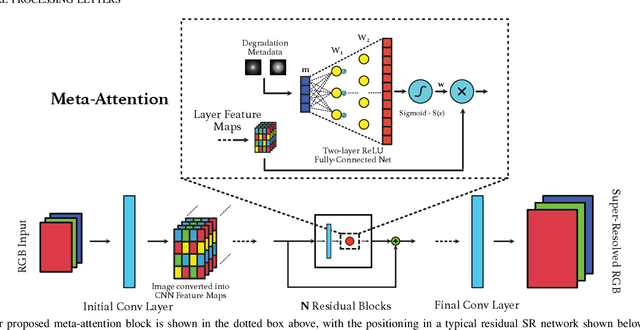
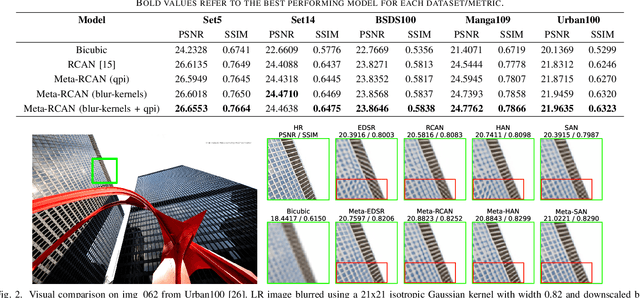
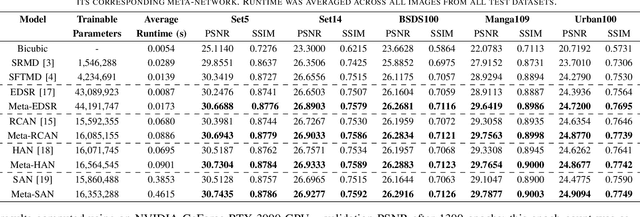
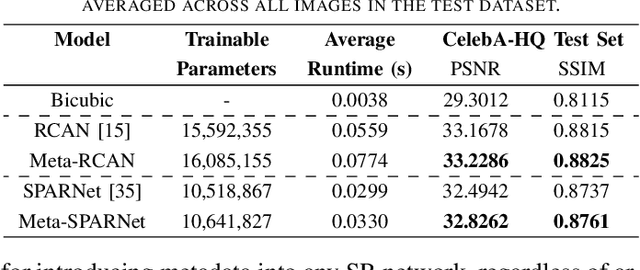
Abstract:Convolutional Neural Networks (CNNs) have achieved impressive results across many super-resolution (SR) and image restoration tasks. While many such networks can upscale low-resolution (LR) images using just the raw pixel-level information, the ill-posed nature of SR can make it difficult to accurately super-resolve an image which has undergone multiple different degradations. Additional information (metadata) describing the degradation process (such as the blur kernel applied, compression level, etc.) can guide networks to super-resolve LR images with higher fidelity to the original source. Previous attempts at informing SR networks with degradation parameters have indeed been able to improve performance in a number of scenarios. However, due to the fully-convolutional nature of many SR networks, most of these metadata fusion methods either require a complete architectural change, or necessitate the addition of significant extra complexity. Thus, these approaches are difficult to introduce into arbitrary SR networks without considerable design alterations. In this paper, we introduce meta-attention, a simple mechanism which allows any SR CNN to exploit the information available in relevant degradation parameters. The mechanism functions by translating the metadata into a channel attention vector, which in turn selectively modulates the network's feature maps. Incorporating meta-attention into SR networks is straightforward, as it requires no specific type of architecture to function correctly. Extensive testing has shown that meta-attention can consistently improve the pixel-level accuracy of state-of-the-art (SOTA) networks when provided with relevant degradation metadata. For PSNR, the gain on blurred/downsampled (X4) images is of 0.2969 dB (on average) and 0.3320 dB for SOTA general and face SR models, respectively.
Machine Learning for Galaxy Morphology Classification
Jun 01, 2010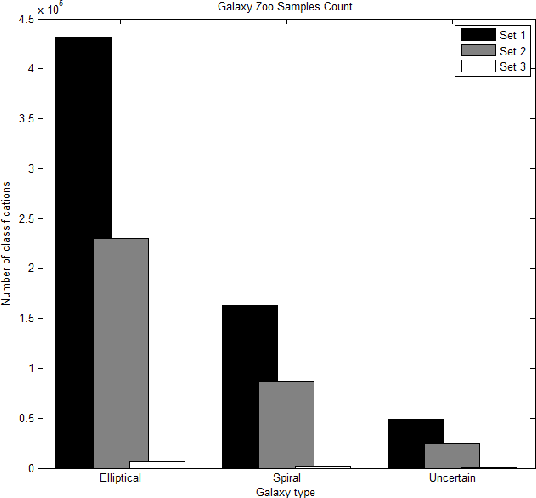

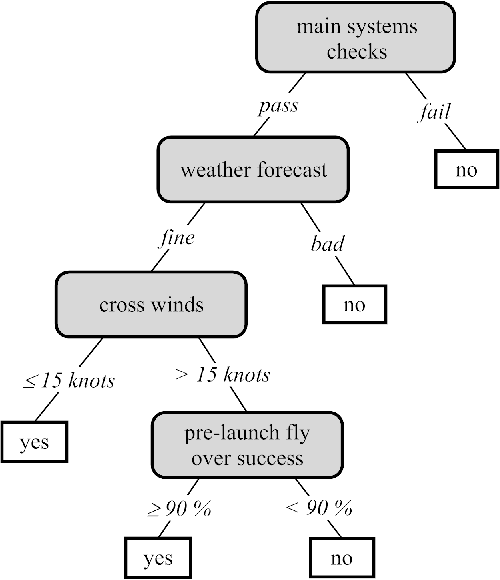
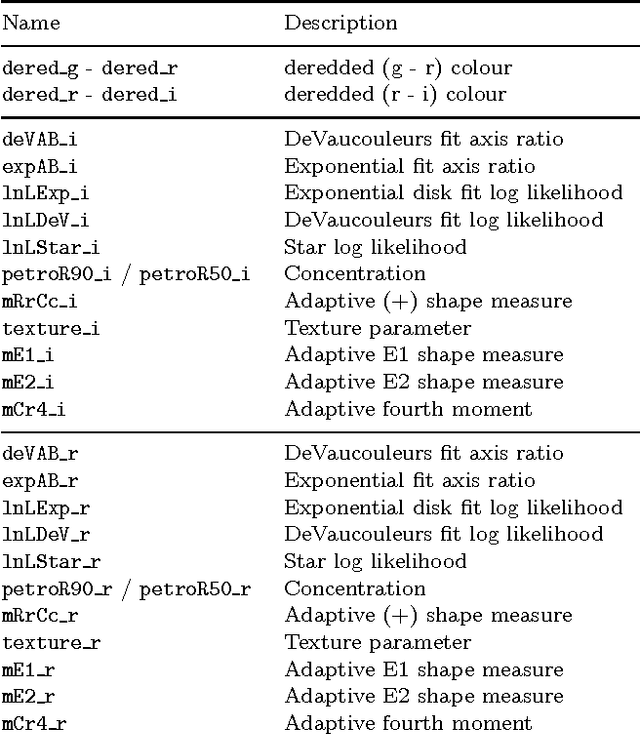
Abstract:In this work, decision tree learning algorithms and fuzzy inferencing systems are applied for galaxy morphology classification. In particular, the CART, the C4.5, the Random Forest and fuzzy logic algorithms are studied and reliable classifiers are developed to distinguish between spiral galaxies, elliptical galaxies or star/unknown galactic objects. Morphology information for the training and testing datasets is obtained from the Galaxy Zoo project while the corresponding photometric and spectra parameters are downloaded from the SDSS DR7 catalogue.
 Add to Chrome
Add to Chrome Add to Firefox
Add to Firefox Add to Edge
Add to Edge